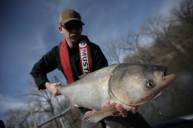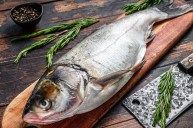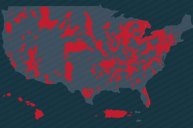The U.S. has long been plagued by a terrifying horde of invasive species, but Asian carp may be the worst.
While there are plenty of candidates vying for the worst invasive species, the carp takes the crown for causing significant and thus-far irreversible problems in a short time frame.
On top of it, there's still limited information about their impact, meaning alarming news about their effect could arrive in coming years.
But already, things don't look good. Asian carp, a collective term for silver, bighead, grass, and black carp species, were introduced in the 1970s by fish farmers as a means to clean commercial ponds. They soon found their way to other waterways, perhaps as a result of flooding.
They have since been found in the waters of nearly half of all the United States and represent over 97 percent of the biomass in portions of the Illinois and Mississippi Rivers. They are also advancing on the Great Lakes, and the effectiveness of the electric barriers that have been set up to halt them is debatable.
Tough Competition
Asian carp outcompete native fish for resources, gobbling up massive quantities of plankton that nearly every other fish relies on. Their voracious appetite for aquatic vegetation also destroys habitat and reduces water quality. This disrupts the fragile balance of several aquatic ecosystems, affecting other animals that depend on fish for their survival.
There are no native fish large enough to eat adult carp themselves, and they are adept at avoiding predators.
They are also a direct nuisance to humans, with silver carp being known to leap out of the water when startled, often colliding with boaters and causing serious injuries or property damage.
If Asian carp are allowed to spread, experts believe they could render significant harm to the $7 billion dollar fishing industry. Since the Asian carp eliminates native fish, it in turn threatens the livelihoods of fishermen and their communities. The threat is credible enough to involve the federal government, which has poured hundreds of millions into projects to keep the carp problem from worsening.
The Enigma
What makes the carp particularly scary is humans have not yet figured how to eliminate them where they've already set up. Rather, most policies focus on containing the threat by stopping or at least slowing their spread to other rivers and lakes. When the best we can hope for is things only don't get worse, the situation is dire.
Expert opinion is divided on what their economic impact might be, and if they will be able to reach, survive, and spawn in certain waterways. All they have to go on is the monumental damage they've already rendered to different waterways. By the time experts agree on what threat the Asian carp poses, it could already be too late to make a meaningful dent in their numbers.
Unfortunately, it doesn't appear we can eat the carp out of existence like we have with some other species. Other invasive animals like lionfish are considered to be good meals, and conservationists encourage eating them to reduce their populations. But there are few Americans who clamor for a good carp recipe.
Some states ship the carp overseas to markets like Asia, where its a popular food staple. Even if they wanted to target them, fishermen can't hope to make too much an impact on the species, as they are difficult to catch with traditional angling methods.
Still, if you happen to catch an Asian carp, whether you plan to eat it or not, do us all a favor and don't throw it back.
NEXT: MONOFILAMENT VS BRAIDED: WHICH LINE IS FOR YOU?
WATCH





